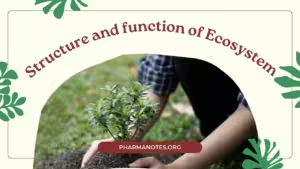Structure and Function of Ecosystem

Intended Learning Outcomes
At the end of this Lecture, students will be able to
• Explain the structural aspects of the Ecosystem
• Discuss functional aspects of the Ecosystem
Structure and function of Ecosystem
Structural aspects
Components that make up the structural aspects of an ecosystem include:
1. Inorganic aspects – C, N, CO2, H2O.
2. Organic compounds – Protein, Carbohydrates, Lipids – link abiotic to biotic aspects
3. Climatic regimes – Temperature, Moisture, Light & Topography.
4. Producers – Plants.
5. Macro consumers – Phagotrophs – Large Animals.
6. Micro consumers – Saprotrophs, absorbers – fungi.
Functional aspects
1. Energy cycles.
2. Food chains.
3. Diversity-interlinkages between organisms.
4. Nutrient cycles-biogeochemical cycles.
5. Evolution
• Since each ecosystem has a non-living and a living part that is linked to each other, one needs to look around us and observe this closely
• This is an important aspect that is a vital part of our lives
• The non-living components of an ecosystem are the amount of water, the various inorganic substances, and organic compounds and climatic conditions such as rainfall and temperature, which depend on geographical conditions and location which is also related to the amount of sunlight
• The living organisms in an ecosystem are inseparable from their habitat
• The living component of plant life ranges from extremely small bacteria, which live in air, water, and soil, algae which live in fresh and saltwater to the terrestrial plants which range from grasses and herbs that grow after the monsoon every year, to the giant long-lived trees of the forest
• The plants convert energy from sunlight into organic matter for their growth
• They thus function as producers in the ecosystem
• The living component of the animal world ranges from microscopic animals to small insects and larger animals such as fish, amphibia, reptiles, birds and mammals
• Man is just one of the 1.8 million species of plants and animals that inhabit the earth
Producer
• Every living organism is in some way dependent on other organisms
• Plants are food for herbivorous animals which are in turn food for carnivorous animals
• Thus there are different tropic levels in the ecosystem
• Some organisms such as fungi live only on dead material and inorganic matter
• Plants are the producers in the ecosystem as they manufacture their food by using energy from the sun
• In the forest these form communities of plant life
• In the sea these include tiny algal forms to large seaweed
• Herbivorous animals are primary consumers as they live on the producers
• In a forest, these are the insects, amphibian, reptiles, birds, and mammals
• Herbivorous animals include for example hare, deer, and elephants that live on plant life
• They graze on grass or feed on the foliage from trees
• In grasslands, there are herbivores such as the blackbuck that feeds on grass
• In the sea, there are small fish that live on algae and other plants
• At a higher tropic level, there are carnivorous animals or secondary consumers, which live on herbivorous animals
• In our forests, the carnivorous animals are tigers, leopards, jackals, foxes and small wild cats
• In the sea, carnivorous fish live on other fish and marine animals
• Animals that live in the sea range in size from microscopic forms to giant mammals such as the whale
• Decomposers or detrivores are a group of organisms consisting of small animals like worms, insects, bacteria, and fungi, which break down dead organic material into smaller particles and finally into simpler substances that are used by plants as nutrition
• Decomposition thus is a vital function in nature, as without this, all the nutrients would be tied up in dead matter and no new life could be produced
• Most ecosystems are highly complex and consist of an extremely large number of individuals of a wide variety of species
• In species-rich tropical ecosystems (such as in our country), only a few species are very common, while most species have relatively few individuals. Some species of plants and animals are extremely rare and may occur only in a few locations. These are said to be ‘endemic’ to these areas
• When human activities alter the balance in these ecosystems, the “perturbation” leads to the disappearance of these uncommon species
• When this happens to an endemic species that is not widely distributed, it becomes extinct for all time
Summary
Structural aspects are
• Inorganic aspects – C, N, CO2, H2O
• Organic compounds – Protein, Carbohydrates, and Lipids – link abiotic to biotic aspects
• Climatic regimes – Temperature, Moisture, Light & Topography
• Producers – Plants
• Macro consumers – Phagotrophs – Large animals
• Micro consumers – Saprotrophs, absorbers – fungi
Functional aspects are
• Energy cycles
• Food chains
• Diversity-interlinkages between organisms
• Nutrient cycles-biogeochemical cycles
• Evolution
Also, Visit:
B. Pharma Notes | B. Pharma Notes | Study material Bachelor of Pharmacy pdf